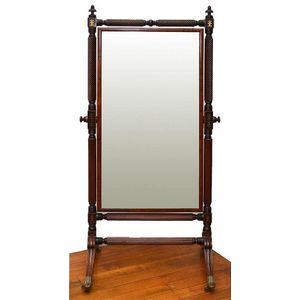Octagonal Mahogany Cheval Mirror with Scroll Legs
You must be a subscriber, and be logged in to view price and dealer details.
Subscribe Now to view actual auction price for this item
When you subscribe, you have the option of setting the currency in which to display prices to $Au, $US, $NZ or Stg.
- Scroll Legs - are in the form of an elongated scroll or 's' shape, from which the cabriole leg also derived. Scroll legs, however, are usually rather more substantial and are frequently found supporting side tables and hall tables throughout much of the 19th century. As a rule, the back legs of such tables intended to remain against the wall were flat and rectangular.
- Victorian Period - The Victorian period of furniture and decorative arts design covers the reign of Queen Victoria from 1837 to 1901. There was not one dominant style of furniture in the Victorian period. Designers used and modified many historical styles such as Gothic, Tudor, Elizabethan, English Rococo, Neoclassical and others, although use of some styles, such as English Rococo and Gothic tended to dominate the furniture manufacture of the period.
The Victorian period was preceded by the Regency and William IV periods, and followed by the Edwardian period, named for Edward VII (1841 ? 1910) who was King of the United Kingdom and the British Dominions and Emperor of India for the brief period from 1901 until his death in 1910. - Stretcher - A horizontal rail which connects the legs of stools, chairs, tables and stands, to provide stabilisation of the legs. A stretcher table is any table with a stretcher base. The term is usually applied to substantial farmhouse tables, although many cabinetmaker's pieces, such as sofa tables, also have turned stretchers.
- Mahogany - Mahogany is a dense, close grained red-coloured timber from the West Indies and Central America. It was first imported into Europe in the the early 18th century and its use continued through the 19th century. It was popular for furniture making because of its strength, the wide boards available, the distinctive grain on some boards, termed flame mahogany and the rich warm colour of the timber when it was polished.. The "flame" was produced where a limb grew out from the trunk of the tree, and this timber was usually sliced into veneers for feature panels on doors, backs and cornices.
Some terms used to describe mahogany relate to the country from which it originally came, such as "Cuban" mahogany, "Honduras" mahogany etc. However unless the wood has been tested the names assigned are more a selling feature, rather than a true indication of the timber's origin.
This item has been included into following indexes:
Visually similar items

A mahogany cheval mirror, English, early 19th century, 159 cm high, 85 cm wide, 66 cm deep

Australian cedar one-drawer writing desk with embossed brown leather insert top; resting on turned legs, c1880s. Has been restored, some scratches on the back edge of the top. Fair/good condition

A 19th century brass inlaid mahogany cheval mirror the rectangular plate within twist turned supports with fleur de lys brass inlay, above scroll legs united by a cross stretcher, brass caps and castors, 194 x 97 cm

An Australian cedar dressing mirror on matched stand, 19th century a rectangular framed mirror glass supported between two turned supports, above platform base with moulded edge and standing on squat bun feet 60 cm high, 60 cm wide, 29.5 cm deep
